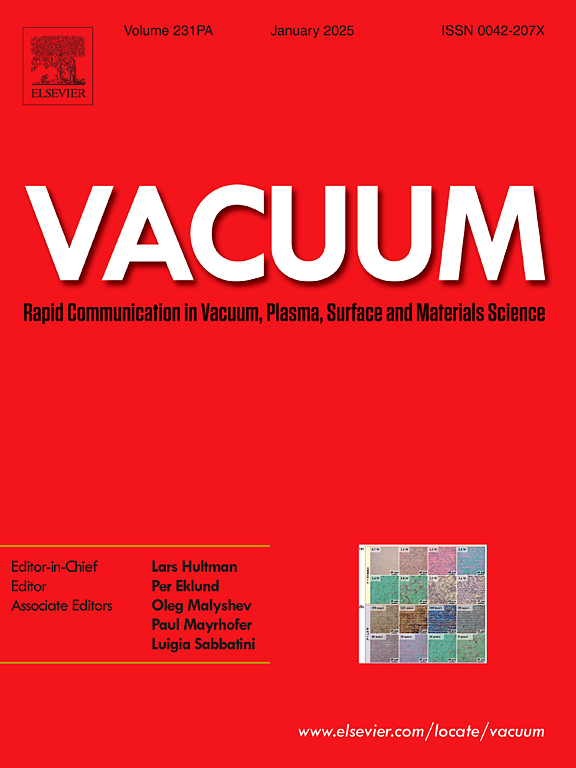氟对磁控溅射沉积VO2薄膜结构和电性能的影响
IF 3.8
2区 材料科学
Q2 MATERIALS SCIENCE, MULTIDISCIPLINARY
引用次数: 0
摘要
本研究探讨了在氧化钒(VO2)薄膜的电测量中使用的氟基热凝胶是否会影响薄膜的结构、形态或成分完整性。采用磁控溅射法制备了高质量的金属-绝缘体过渡VO2薄膜,其电阻比变化约为104。在电学表征过程中,使用氟基热凝胶将VO2薄膜从室温加热到~ 370 K,以实现薄膜和衬底支架之间更好的热接触。通过XRD, Raman, XPS, SEM和能量色散光谱成像评估了结构和化学性能。XRD显示的衍射峰与单斜VO2一致,证实了尽管使用了氟基热凝胶,但晶格仍然保持不变。拉曼光谱显示出振动模式,表明尽管使用氟凝胶,VO2的声子结构仍保持不变。XPS结果显示,仅在薄膜表面有微弱的f1s信号(2.8%)。SEM和EDS分析进一步证实了表面形貌和元素组成仍属于VO2膜。这些发现表明,氟基热凝胶的使用只导致最小的表面相互作用,从而保留了VO2的固有材料特性,并支持未来设备制造应用的潜在用途。本文章由计算机程序翻译,如有差异,请以英文原文为准。
Influence of fluorine on structural and electrical properties of VO2 thin films deposited by magnetron sputtering
This study investigates whether fluorine-based thermal gel used during electrical measurements of vanadium oxide (VO2) films influences the structural, morphological, or compositional integrity of the films. High-quality VO2 films with a resistance ratio change of about 104 for metal–insulator transition were deposited by magnetron sputtering. During electrical characterization, VO2 film was heated from room temperature to ∼370 K with a fluorine-based thermal gel usage to achieve better heat contact between the film and substrate holder. Structural and chemical properties were assessed through XRD, Raman, XPS, SEM, and energy dispersive spectroscopy imaging. XRD revealed diffraction peaks consistent with monoclinic VO2 confirming that the crystal lattice remains the same although fluorine based thermal gel was used. Raman spectra exhibited vibrational modes indicating that the phonon structure of VO2 was preserved despite fluorine gel usage. XPS results showed only a minor F 1s signal (2.8%) limited only to the film surface. SEM and EDS analyses further confirmed that surface morphology and elemental composition remained belonging to VO2 film. These findings demonstrate that the usage of fluorine-based thermal gel results in only a minimal surface interaction, thereby preserving intrinsic material properties of VO2 and supporting a potential usage for future device fabrication applications.
求助全文
通过发布文献求助,成功后即可免费获取论文全文。
去求助
来源期刊

Vacuum
工程技术-材料科学:综合
CiteScore
6.80
自引率
17.50%
发文量
0
审稿时长
34 days
期刊介绍:
Vacuum is an international rapid publications journal with a focus on short communication. All papers are peer-reviewed, with the review process for short communication geared towards very fast turnaround times. The journal also published full research papers, thematic issues and selected papers from leading conferences.
A report in Vacuum should represent a major advance in an area that involves a controlled environment at pressures of one atmosphere or below.
The scope of the journal includes:
1. Vacuum; original developments in vacuum pumping and instrumentation, vacuum measurement, vacuum gas dynamics, gas-surface interactions, surface treatment for UHV applications and low outgassing, vacuum melting, sintering, and vacuum metrology. Technology and solutions for large-scale facilities (e.g., particle accelerators and fusion devices). New instrumentation ( e.g., detectors and electron microscopes).
2. Plasma science; advances in PVD, CVD, plasma-assisted CVD, ion sources, deposition processes and analysis.
3. Surface science; surface engineering, surface chemistry, surface analysis, crystal growth, ion-surface interactions and etching, nanometer-scale processing, surface modification.
4. Materials science; novel functional or structural materials. Metals, ceramics, and polymers. Experiments, simulations, and modelling for understanding structure-property relationships. Thin films and coatings. Nanostructures and ion implantation.
 求助内容:
求助内容: 应助结果提醒方式:
应助结果提醒方式:


